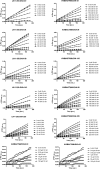Activity of the β-Lactamase Inhibitor LN-1-255 against Carbapenem-Hydrolyzing Class D β-Lactamases from Acinetobacter baumannii
- PMID: 28807908
- PMCID: PMC5655052
- DOI: 10.1128/AAC.01172-17
Activity of the β-Lactamase Inhibitor LN-1-255 against Carbapenem-Hydrolyzing Class D β-Lactamases from Acinetobacter baumannii
Abstract
The number of infections caused by Gram-negative pathogens carrying carbapenemases is increasing, and the group of carbapenem-hydrolyzing class D β-lactamases (CHDLs) is especially problematic. Several clinically important CHDLs have been identified in Acinetobacter baumannii, including OXA-23, OXA-24/40, OXA-58, OXA-143, OXA-235, and the chromosomally encoded OXA-51. The selection and dissemination of carbapenem-resistant A. baumannii strains constitutes a serious global threat. Carbapenems have been successfully utilized as last-resort antibiotics for the treatment of multidrug-resistant A. baumannii infections. However, the spread of OXA carbapenemases is compromising the continued use of these antimicrobials. In response to this clinical issue, it is necessary and urgent to design and develop new specific inhibitors with efficacy against these enzymes. The aim of this work was to characterize the inhibitory activity of LN-1-255 (a 6-alkylidene-2-substituted penicillin sulfone) and compare it to that of two established inhibitors (avibactam and tazobactam) against the most relevant enzymes of each group of class D carbapenemases in A. baumannii The β-lactamase inhibitor LN-1-255 demonstrated excellent microbiological synergy and inhibition kinetics parameters against all tested CHDLs and a significantly higher activity than tazobactam and avibactam. A combination of carbapenems and LN-1-255 was effective against A. baumannii class D carbapenemases. Docking assays confirmed the affinity of LN-1-255 for the active site of these enzymes. LN-1-255 represents a potential new β-lactamase inhibitor that may have a significant role in eradicating infections caused by A. baumannii isolates carrying CHDLs.
Keywords: Acinetobacter baumannii; antimicrobial resistance; carbapenem-hydrolyzing class D β-lactamases; β-lactamase inhibitors.
Copyright © 2017 American Society for Microbiology.
Figures





Similar articles
-
Therapeutic Efficacy of LN-1-255 in Combination with Imipenem in Severe Infection Caused by Carbapenem-Resistant Acinetobacter baumannii.Antimicrob Agents Chemother. 2019 Sep 23;63(10):e01092-19. doi: 10.1128/AAC.01092-19. Print 2019 Oct. Antimicrob Agents Chemother. 2019. PMID: 31383666 Free PMC article.
-
Targeting Multidrug-Resistant Acinetobacter spp.: Sulbactam and the Diazabicyclooctenone β-Lactamase Inhibitor ETX2514 as a Novel Therapeutic Agent.mBio. 2019 Mar 12;10(2):e00159-19. doi: 10.1128/mBio.00159-19. mBio. 2019. PMID: 30862744 Free PMC article.
-
C6 Hydroxymethyl-Substituted Carbapenem MA-1-206 Inhibits the Major Acinetobacter baumannii Carbapenemase OXA-23 by Impeding Deacylation.mBio. 2022 Jun 28;13(3):e0036722. doi: 10.1128/mbio.00367-22. Epub 2022 Apr 14. mBio. 2022. PMID: 35420470 Free PMC article.
-
Acinetobacter baumannii: biology and drug resistance - role of carbapenemases.Folia Histochem Cytobiol. 2016;54(2):61-74. doi: 10.5603/FHC.a2016.0009. Epub 2016 Jun 8. Folia Histochem Cytobiol. 2016. PMID: 27270503 Review.
-
Carbapenem resistance in Acinetobacter baumannii: mechanisms and epidemiology.Clin Microbiol Infect. 2006 Sep;12(9):826-36. doi: 10.1111/j.1469-0691.2006.01456.x. Clin Microbiol Infect. 2006. PMID: 16882287 Review.
Cited by
-
Comparison of Septic Shock Due to Multidrug-Resistant Acinetobacter baumannii or Klebsiella pneumoniae Carbapenemase-Producing K. pneumoniae in Intensive Care Unit Patients.Antimicrob Agents Chemother. 2018 May 25;62(6):e02562-17. doi: 10.1128/AAC.02562-17. Print 2018 Jun. Antimicrob Agents Chemother. 2018. PMID: 29555630 Free PMC article.
-
Sulfonamidoboronic Acids as "Cross-Class" Inhibitors of an Expanded-Spectrum Class C Cephalosporinase, ADC-33, and a Class D Carbapenemase, OXA-24/40: Strategic Compound Design to Combat Resistance in Acinetobacter baumannii.Antibiotics (Basel). 2023 Mar 24;12(4):644. doi: 10.3390/antibiotics12040644. Antibiotics (Basel). 2023. PMID: 37107006 Free PMC article.
-
Novel Penicillin-Based Sulfone-Siderophore Conjugates for Restoring β-Lactam Antibiotic Efficacy.ACS Omega. 2024 May 28;9(24):26484-26494. doi: 10.1021/acsomega.4c02984. eCollection 2024 Jun 18. ACS Omega. 2024. PMID: 38911797 Free PMC article.
-
Inhibition of the Clostridioides difficile Class D β-Lactamase CDD-1 by Avibactam.ACS Infect Dis. 2021 May 14;7(5):1164-1176. doi: 10.1021/acsinfecdis.0c00714. Epub 2021 Jan 3. ACS Infect Dis. 2021. PMID: 33390002 Free PMC article.
-
The role of adjuvants in overcoming antibacterial resistance due to enzymatic drug modification.RSC Med Chem. 2022 Sep 22;13(11):1276-1299. doi: 10.1039/d2md00263a. eCollection 2022 Nov 16. RSC Med Chem. 2022. PMID: 36439977 Free PMC article. Review.
References
-
- Rosenthal VD, Maki DG, Jamulitrat S, Medeiros EA, Todi SK, Gomez DY, Leblebicioglu H, Abu Khader I, Miranda Novales MG, Berba R, Ramírez Wong FM, Barkat A, Pino OR, Dueñas L, Mitrev Z, Bijie H, Gurskis V, Kanj SS, Mapp T, Hidalgo RF, Ben Jaballah N, Raka L, Gikas A, Ahmed A, Thu TA, Guzmán Siritt ME, INICC Members 2010. International Nosocomial Infection Control Consortium (INICC) report, data summary for 2003-2008, issued June 2009. Am J Infect Control 38:95–104.e2. doi: 10.1016/j.ajic.2009.12.004. - DOI - PubMed
MeSH terms
Substances
Grants and funding
LinkOut - more resources
Full Text Sources
Other Literature Sources
Molecular Biology Databases

